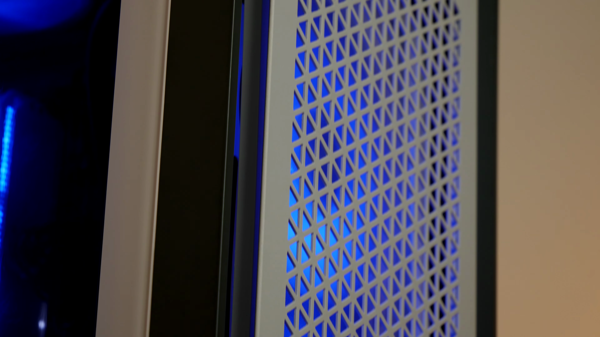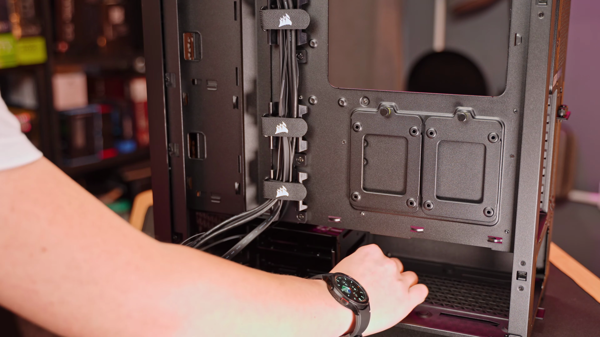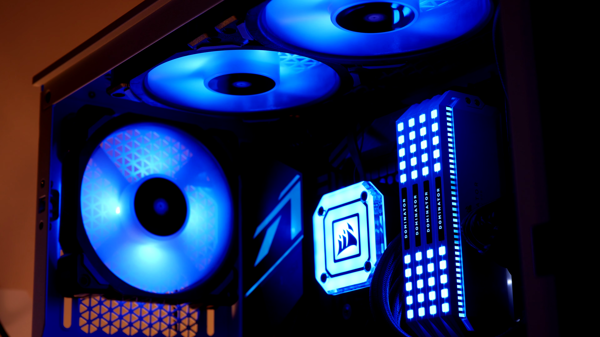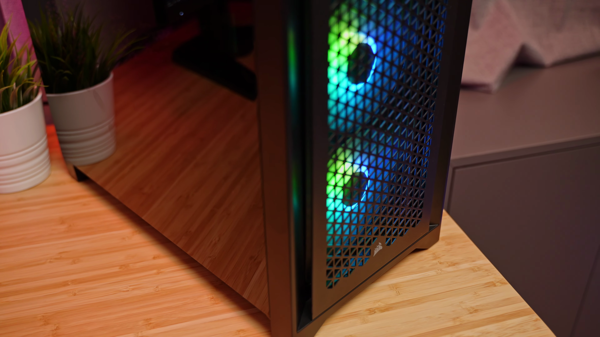Note: As an Amazon Associate I earn from qualifying purchases.
My experience with the CORSAIR 4000D AIRFLOW Mid-Tower Case Black (2024)
Introduction
I recently got my hands on the CORSAIR 4000D AIRFLOW case for a new PC build. Below I’ll share my experiences with the case’s design and build quality, cooling efficiency, cable management, and how adaptable it is for future upgrades. Whether you’re a casual builder or someone looking to put together a high-performance system, this seems to be a good case regardless.
Specifications
| Property | Value | Property | Value |
|---|---|---|---|
| Brand | Corsair | Motherboard Compatability | Extended ATX, ATX, MicroATX, MiniATX |
| Case Type | Mid Tower | Recommended Uses For Product | Gaming |
| Color | Black | Material | Tempered Glass, Alloy Steel, Plastic |
| Cooling Method | Air | Model Name | 4000D AIRFLOW |
| Fan Size | 120 Millimeters | Item Weight | 17.31 Pounds |
Photos
Click on photos to enlarge them:
Prices
Check prices of the CORSAIR 4000D AIRFLOW Mid-Tower Case Black on:
Design and Build Quality of the CORSAIR 4000D AIRFLOW
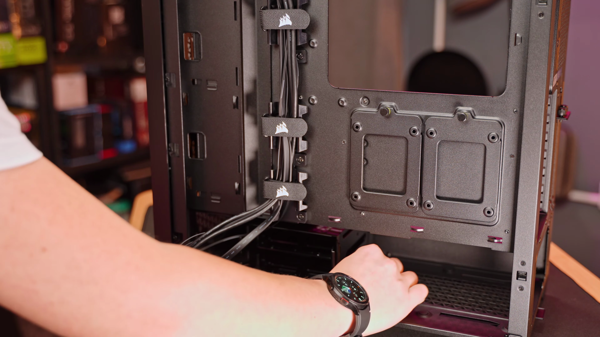
When it comes to the design and build quality of the CORSAIR 4000D AIRFLOW, there are certainly a few highlights and some minor drawbacks worth noting. Straight out of the box, the case strikes an impressive balance between a clean, modern aesthetic and functional design.
Here’s a quick rundown of my initial impressions:
Design Aesthetics: Sporting a steel front panel and tempered glass side, it looks professional and sleek. I appreciate the minimalist vibe it brings to my setup.
Build Materials: The combination of alloy steel with a tempered glass side panel screams durability and I love the sturdy feel.
Front Panel Access: With a USB 3.1 Type-C port and a USB 3.0 port alongside an audio/microphone jack, the I/O is up-to-date and accessible.
Interior Space: There’s ample space inside, making it a breeze to work with, even for a guy with larger hands.
On the flip side, there are a couple of nitpicks:
Included Fans: The case comes with two 120mm fans, which are decent, but they’re not PWM fans, and I’m kind of a stickler for that. I ended up swapping them out pretty quickly.
Front Panel Gap: There’s a noticeable gap at the bottom of the glass panel, which can allow some light to bleed out - not a huge deal but something I’d tweak if I could.
Vertical GPU Mount: While the case supports vertical GPU mounting, the lack of included peripherals for this setup means additional purchases if that’s your preference.
As for the case itself, I’m pretty happy with its versatility. It nicely accommodates a range of motherboard sizes, from Mini-ITX to E-ATX. The provision for both SSDs and HDDs is thoughtful, and the option to vertically display your GPU (though I’ve not used it myself yet) is a nice touch for those who might want to show off their hardware.
The company claims this case is about exceptional cooling performance. While that might sound like marketing fluff, I do believe the airflow design is effective. The steel front panel really isn’t just for looks; it channels air straight into the system and my temperatures have been pretty stable.
I’m also incredibly impressed with the attention to detail for easy builds. Velcro straps for cable management are a godsend. Added bonus points for the thumbscrews on the glass panel being captive, so there’s no chance of misplacing them during disassembly.
Despite the name, color options are somewhat limited. I went with Black, which looks great but doesn’t leave much room for personal flavor unless you’re into modding. And while the construction is solid, some of the interior metal feels a bit thin, so you might want to handle with care during fan installation.
The Corsair 4000D AIRFLOW is a standout for its solid build and thoughtful design. While it’s not perfect, what is? The drawbacks are pretty minor compared to the overall quality and functionality. I can tweak fans, deal with a tiny light bleed, and overlook the lack of a vertical GPU kit, considering those aren’t deal-breakers. Overall, it gets my nod for anyone looking to build a sleek, high-performance rig.
Cooling Efficiency and Airflow Performance

In my hands-on time with the CORSAIR 4000D AIRFLOW, I’ve been notably impressed by its cooling capabilities. Let’s break down its airflow performance and discuss some of the important aspects.
Cooling Efficiency and Airflow:
Optimized Front Panel: The steel front panel isn’t just for show; it serves up a hefty dose of airflow to the components within.
AirGuide Fans: The two included 120mm AirGuide fans are outfitted with anti-vortex vanes, concentrating the airflow and keeping things chill under pressure.
Fan and Radiator Support: There’s versatility with up to 6x 120mm or 4x 140mm fans and radiators up to 360mm in the front and 280mm up top, depending on your RAM height.
Right away, I could feel the difference these features made. The fans that come with it, though they’re not PWM, do a pretty decent job. I admit, I swapped them out for some top-tier fans for that extra peace of mind and control. That cool and quiet operation became the sweet spot for me, especially under load.
However, nothing’s perfect. There’s a bit of imbalance when it comes to front-to-back airflow due to the design focussing heavily on the front intake. This isn’t unusual in cases though, and adding a couple more fans easily rectifies any concerns over hotspots.
Something I’ve noticed about the airflow pattern is that it does a great job at directing air right where you need it—over the GPU and CPU. The dust filtration system also impresses, with its fine mesh catching the smallest particles while not suffocating the case. It’s a breeze to maintain and has kept the internals spotless so far.
During my usage, even with overclocked gear, I’ve found temperatures to remain steady. This case isn’t just about moving air; it’s also about moving it smartly. The fact that there’s ample space above the motherboard was a godsend, making the CPU power cable routing a non-issue—another indirect plus for airflow optimization since there are no cables to disrupt the flow.
But, I do want to point out that you should think about your fan curve and overall setup to ensure you aren’t pulling in more dust than necessary or making the case noisier than it needs to be. It’s a balance you’ll have to tweak.
Honestly, the airflow in the 4000D AIRFLOW has lived up to its name in my books. It’s kept my build cool without turning the space into a wind tunnel, and with a few personal touches, it’s near silent even when I’m pushing my system. The airflow design of this case gets two thumbs up from me—just make sure you’re ready to dial in your fan setup for the best balance of quiet operation and thermal performance.
Cable Management and Ease of Building

Building my latest rig in the CORSAIR 4000D AIRFLOW case, the experience with cable management and ease of assembly was definitely something to talk about. Here’s the rundown:
The RapidRoute cable management system is as good as advertised. It gives you a designated channel behind the motherboard tray, making it a breeze to route and hide cables. The 25mm of space is pretty generous, and you can tuck away the bulk of your cables with ease.
Velcro cable ties were included and they’re clutch for keeping things tidy without resorting to the permanence of zip ties. These are a godsend when you need to re-route or make changes to your setup.
Tool-less side panels with captive screws are convenient, reducing the fiddling around with screws when you’re itching to dive into the build or when doing maintenance.
Now, while the system is almost foolproof, there were instances where it took a bit of extra effort. The SSD trays behind the motherboard were tight - sometimes a little too tight. I felt like I needed more muscle than I should have just to secure the drives and the cables neatly in place. Also, some folks might find the supplied fans a bit underwhelming; they’re not terrible, but I swapped mine out for some PWM fans for better control and quieter operation.
What stood out to me was the sheer amount of cable routing cutouts and tie-down points. It’s apparent CORSAIR considered multiple build configurations when they designed this case. Whether you’re a builder who is all about that neat, uncluttered look or someone who just wants an easy setup without much fuss, this case has got you covered.
However, it wasn’t all perfect. Those pre-installed screws - they mean well but were over-tightened in my case. It wasn’t anything some elbow grease couldn’t handle, but a heads-up for builders who prefer to avoid unexpected workouts. Furthermore, the front I/O panel’s USB Type-C cable could pose compatibility issues if your motherboard lacks the corresponding header. This isn’t a dealbreaker, just something to keep in mind during your build prep.
Overall, constructing a system within the 4000D AIRFLOW is a pleasant affair. Yes, you might hit a couple of snags here and there, but the pros overwhelmingly outweigh the cons when it comes to the build experience. From well-thought-out design features to excellent cable management options, CORSAIR has put together a case that makes the building process approachable and leaves you with a setup to be proud of.
Adaptability and Future-Proofing Capabilities

When it comes to the adaptability and future-proofing of the CORSAIR 4000D AIRFLOW, I’ve found a lot to like. A key part of future-proofing any system is ensuring that it can accommodate technological advancements and changes in user requirements. Here’s a rundown of what stands out:
Motherboard Compatibility: The case supports a wide range of motherboard sizes, which means I won’t be stuck if I decide to upgrade to a larger or smaller board in the future.
Cooling Options: With space for up to six 120mm fans or four 140mm fans and multiple radiators, cooling isn’t going to be an issue, even as components get more powerful and possibly generate more heat.
Storage Options: The ability to fit multiple SSDs and HDDs, with relocatable trays, gives me the flexibility to expand storage as needed.
Despite these positives, there’s room for improvement. The lack of PWM fans and difficulty in accessing certain SSD mounts are minor gripes that don’t break the deal but are definitely worth considering.
Another thing to consider is the front I/O panel, which is a double-edged sword. It’s conveniently modern with its USB-C port, but with only one traditional USB 3.0 port, it might leave some wanting more, especially considering the growing number of USB devices in our setups.
The adaptability extends to the ease of making the PC your own. Swapping out fans, adding an AIO cooler, or changing up the GPU setup is straightforward, which isn’t always the case with other mid-tower options. Plus, the vertical GPU mount option (even though the riser cable isn’t included) is a nice touch for showing off your graphics card while keeping it secure.
All these features lead to a case that not only looks the part now but should still be a contender years down the line. The ease of access and management means it’s also a breeze to swap out parts – a major plus for anyone who upgrades frequently.
Overall, the 4000D AIRFLOW feels like a smart choice for builders who want a case that won’t hold them back as their PC evolves. It’s not without its shortcomings, like the lack of PWM fans or a limited front I/O panel – but these are far from deal-breakers.
In closing, the adaptability of the 4000D AIRFLOW gets the thumbs up from me with some caveats–it’s a solid investment for someone who wants a case that will grow with them. It’s all about balancing act between current needs and future expansions, and this case checks most of the boxes.
